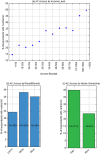Heat, Disparities, and Health Outcomes in San Diego County's Diverse Climate Zones
- PMID: 32159015
- PMCID: PMC7007153
- DOI: 10.1029/2017GH000127
Heat, Disparities, and Health Outcomes in San Diego County's Diverse Climate Zones
Abstract
Climate variability and change are issues of growing public health importance. Numerous studies have documented risks of extreme heat on human health in different locations around the world. Strategies to prevent heat-related morbidity and reduce disparities are possible but require improved knowledge of health outcomes during hot days at a small-scale level as important within-city variability in local weather conditions, socio-demographic composition, and access to air conditioning (AC) may exist. We analyzed hospitalization data for three unique climate regions of San Diego County alongside temperature data spanning 14 years to quantify the health impact of ambient air temperature at varying exceedance threshold levels. Within San Diego, coastal residents were more sensitive to heat than inland residents. At the coast, we detected a health impact at lower temperatures compared to inland locations for multiple disease categories including heat illness, dehydration, acute renal failure, and respiratory disease. Within the milder coastal region where access to AC is not prevalent, heat-related morbidity was higher in the subset of zip codes where AC saturation is lowest. We detected a 14.6% increase (95% confidence interval [4.5%, 24.6%]) in hospitalizations during hot weather in comparison to colder days in coastal locations where AC is less common, while no significant impact was observed in areas with higher AC saturation. Disparities in AC ownership were associated with income, race/ethnicity, and homeownership. Given that heat waves are expected to increase with climate change, understanding health impacts of heat and the role of acclimation is critical for improving outcomes in the future.
Keywords: air conditioning; climate zones; disparities; health outcomes; heat extremes; temperature.
©2018. The Authors.
Conflict of interest statement
The authors declare no conflicts of interest relevant to this study.
Figures







References
-
- Basu, R. , & Malig, B. (2011). High ambient temperature and mortality in California: Exploring the roles of age, disease, and mortality displacement. Environmental Research, 111, 1286–1292. - PubMed
-
- Basu, R. , Pearson, D. , Malig, B. , Broadwin, R. , & Green, S. (2012). The effect of elevated ambient temperature on emergency room visits. Epidemiology, 23, 813–820. - PubMed
